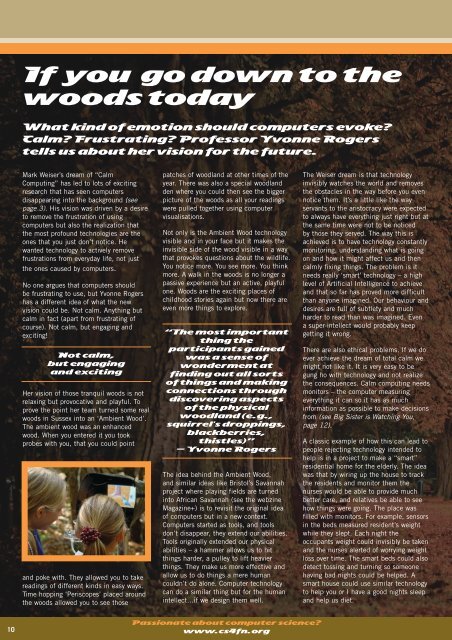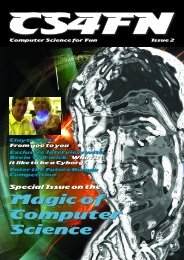a pdf version - cs4fn
a pdf version - cs4fn
a pdf version - cs4fn
Create successful ePaper yourself
Turn your PDF publications into a flip-book with our unique Google optimized e-Paper software.
If you go down to thewoods todayWhat kind of emotion should computers evoke?Calm? Frustrating? Professor Yvonne Rogerstells us about her vision for the future.Mark Weiser’s dream of “CalmComputing” has led to lots of excitingresearch that has seen computersdisappearing into the background (seepage 3). His vision was driven by a desireto remove the frustration of usingcomputers but also the realization thatthe most profound technologies are theones that you just don’t notice. Hewanted technology to actively removefrustrations from everyday life, not justthe ones caused by computers.No one argues that computers shouldbe frustrating to use, but Yvonne Rogershas a different idea of what the newvision could be. Not calm. Anything butcalm in fact (apart from frustrating ofcourse). Not calm, but engaging andexciting!Not calm,but engagingand excitingHer vision of those tranquil woods is notrelaxing but provocative and playful. Toprove the point her team turned some realwoods in Sussex into an ‘Ambient Wood’.The ambient wood was an enhancedwood. When you entered it you tookprobes with you, that you could pointand poke with. They allowed you to takereadings of different kinds in easy ways.Time hopping ‘Periscopes’ placed aroundthe woods allowed you to see thosepatches of woodland at other times of theyear. There was also a special woodlandden where you could then see the biggerpicture of the woods as all your readingswere pulled together using computervisualisations.Not only is the Ambient Wood technologyvisible and in your face but it makes theinvisible side of the wood visible in a waythat provokes questions about the wildlife.You notice more. You see more. You thinkmore. A walk in the woods is no longer apassive experience but an active, playfulone. Woods are the exciting places ofchildhood stories again but now there areeven more things to explore.“The most importantthing theparticipants gainedwas a sense ofwonderment atfinding out all sortsof things and makingconnections throughdiscovering aspectsof the physicalwoodland (e.g.,squirrel's droppings,blackberries,thistles)”– Yvonne RogersThe idea behind the Ambient Wood,and similar ideas like Bristol’s Savannahproject where playing fields are turnedinto African Savannah (see the webzineMagazine+) is to revisit the original ideaof computers but in a new context.Computers started as tools, and toolsdon’t disappear, they extend our abilities.Tools originally extended our physicalabilities – a hammer allows us to hitthings harder, a pulley to lift heavierthings. They make us more effective andallow us to do things a mere humancouldn’t do alone. Computer technologycan do a similar thing but for the humanintellect…if we design them well.The Weiser dream is that technologyinvisibly watches the world and removesthe obstacles in the way before you evennotice them. It’s a little like the wayservants to the aristocracy were expectedto always have everything just right but atthe same time were not to be noticedby those they served. The way this isachieved is to have technology constantlymonitoring, understanding what is goingon and how it might affect us and thencalmly fixing things. The problem is itneeds really ‘smart’ technology – a highlevel of Artificial Intelligence to achieveand that so far has proved more difficultthan anyone imagined. Our behaviour anddesires are full of subtlety and muchharder to read than was imagined. Evena super-intellect would probably keepgetting it wrong.There are also ethical problems. If we doever achieve the dream of total calm wemight not like it. It is very easy to begung ho with technology and not realizethe consequences. Calm computing needsmonitors – the computer measuringeverything it can so it has as muchinformation as possible to make decisionsfrom (see Big Sister is Watching You,page 12).A classic example of how this can lead topeople rejecting technology intended tohelp is in a project to make a “smart”residential home for the elderly. The ideawas that by wiring up the house to trackthe residents and monitor them thenurses would be able to provide muchbetter care, and relatives be able to seehow things were going. The place wasfilled with monitors. For example, sensorsin the beds measured resident’s weightwhile they slept. Each night theoccupants weight could invisibly be takenand the nurses alerted of worrying weightloss over time. The smart beds could alsodetect tossing and turning so someonehaving bad nights could be helped. Asmart house could use similar technologyto help you or I have a good nights sleepand help us diet.10Passionate about computer science?www.<strong>cs4fn</strong>.org





